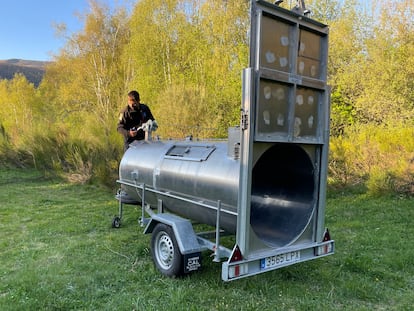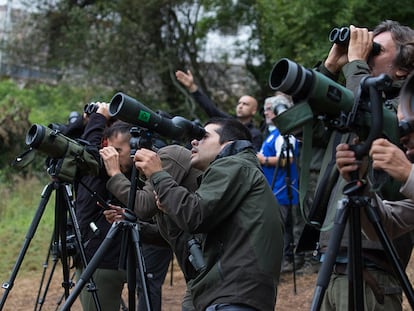Slovakia to cull 350 brown bears after fatal attack
In other parts of the world, programs are being implemented to prevent problematic bears from becoming accustomed to the presence of humans

Slovakia has declared a state of emergency throughout the country following a fatal brown bear attack on a 59-year-old man, who died in the Detva region in the center of the country, a few days ago. Following the incident, the government has approved the culling of up to 350 brown bears, a number very similar to the total bear population in Spain — there are about 370 between the Cantabrian coast and the Pyrenees — and about a quarter of all bears in the Central European country (about 1,300, according to the BBC). Bear attacks are rare in Spain because the government implements programs to prevent them from becoming accustomed to the presence of humans.
“We can’t live in a country where people are afraid of going to forests, where people become food for bears. The intensity of bear attacks is increasing significantly, and we are in a period when they should be hibernating,” Slovakian Prime Minister Robert Fico said Thursday after a Cabinet meeting, in which the measure was approved.
“Slovakia will address preventive abatement in areas, as is the case in Romania. While there were some 650 bear encounters in 2020, there were as many as 1,900 last year. The increase is absolutely clear; the figure goes up every year,” said Environment Minister Tomáš Taraba. Regarding attacks on people, 108 have been recorded in the Central European country over the past 25 years, according to official data.
These bear attacks have resulted in human fatalities only twice: last October in Liptovský Mikuláš, in the north of the country, and now in Detva, although there have been injuries and the presence of these animals has kept many communities on edge. Meanwhile, the number of animals slaughtered since 2000 has risen to 604 individuals, with 2024 being a record year: 94 shot and 50 killed as a result of traffic accidents, poisoning, poaching, or intraspecies attacks, according to data from the same ministry.
The state plans to kill 350 bears, reducing the brown bear population to fewer than 1,150 individuals, a figure estimated by experts based on data from six years ago. Taraba estimates that a total population of 800 animals is sufficient for the species to be viable. The emergency situation declared by the Slovakian government requires the removal of all bait, while the elimination of the animals can only be carried out by emergency teams, not hunters.
Greenpeace Slovakia and other environmental and conservation organizations have harshly criticized the government's decision to prioritize the killing of brown bears, arguing that it ignores scientific evidence and jeopardizes biodiversity conservation. These NGOs maintain that conflicts with these animals often stem from improper waste and food management, and that there are effective, non-lethal methods to prevent incidents.

An endangered animal in Spain
In Spain, brown bears were critically endangered in the 1980s, with around 60 or 70 individuals remaining in two scattered regions (the Cantabrian coast and the Pyrenees). An ambitious recovery program has increased the population to 370 animals in four decades. The risk now is that some animals will approach towns and become habituated to humans, causing incidents or dangerous situations. To prevent this, the region of Asturias has implemented a program to control what it calls problematic bears, that is, those that approach containers or houses because that’s where they can most easily obtain food.
When a bear is considered to be engaging in these behaviors, a cylindrical trap filled with food is set up. When the bear enters, it is put to sleep, blood and fur samples are taken to assess its health, and a GPS collar is fitted to help understand its movements. This is where the second phase begins, called “conditioned aversion”: its movements are tracked, and when it approaches a food source in a village, wildlife rangers are alerted. The moment it begins to eat, non-lethal rubber bullets are fired at it so the animal associates the two sensations and won’t do it again. This prevents many encounters between bears and people.
Sign up for our weekly newsletter to get more English-language news coverage from EL PAÍS USA Edition
Tu suscripción se está usando en otro dispositivo
¿Quieres añadir otro usuario a tu suscripción?
Si continúas leyendo en este dispositivo, no se podrá leer en el otro.
FlechaTu suscripción se está usando en otro dispositivo y solo puedes acceder a EL PAÍS desde un dispositivo a la vez.
Si quieres compartir tu cuenta, cambia tu suscripción a la modalidad Premium, así podrás añadir otro usuario. Cada uno accederá con su propia cuenta de email, lo que os permitirá personalizar vuestra experiencia en EL PAÍS.
¿Tienes una suscripción de empresa? Accede aquí para contratar más cuentas.
En el caso de no saber quién está usando tu cuenta, te recomendamos cambiar tu contraseña aquí.
Si decides continuar compartiendo tu cuenta, este mensaje se mostrará en tu dispositivo y en el de la otra persona que está usando tu cuenta de forma indefinida, afectando a tu experiencia de lectura. Puedes consultar aquí los términos y condiciones de la suscripción digital.

